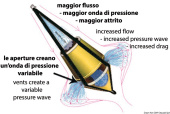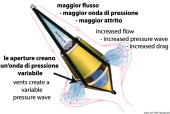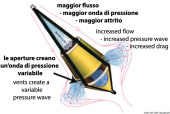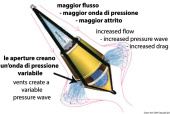A floating anchor, also known as a float anchor or drogue anchor, is a device used to control the speed and direction of a boat or yacht in water. It consists of a buoyant object attached to a line or chain, which is deployed from the stern or bow of the vessel.
|
1-2 weeks delivery time The Mini Sea Floating Anchor is a compact and lightweight drift-prevention device, designed to be attached to a life jacket to prevent a person overboard from being carried away by the current. Made for enhanced safety in emergency situations, it provides resistance against drift while ensuring visibility and stability in the water.
|
$ 24,24
-
+
| |||
|
1-2 weeks delivery time The Sea-Drogue Floating Anchor is a professional-grade drift control device, designed to stabilize boats in rough waters. Made from high-quality PVC-coated wide-weave nylon fabric, it features reinforced bushings and towing strips for maximum durability. Available in four sizes (600 mm to 1350 mm) to suit boats from 6 to 12 meters.
|
$ 27,29
Diameter, mm:
| |||
|
1-2 weeks delivery time The Floating Anchor Drogue Squidy is a durable and reliable anchor made from PVC-infused nylon, reinforced with nylon tape. Available in sizes for boats ranging from 6 to 12 meters, it provides effective support during storms or rafting along rivers. The solid design ensures long-lasting performance, offering you peace of mind in harsh conditions.
|
$ 31,34
Diameter, mm:
| |||
|
1-2 weeks delivery time The Floating Sea Nylon Anchor Parachute is designed to stabilize the vessel's course with ease. While it offers less stability than a traditional anchor, its quick and simple deployment makes it a convenient option to reduce boat movement and prevent unnecessary strain on the boat.
|
$ 81,36
Diameter, mm:
| |||
|
1-2 weeks delivery time The Double Cone Floating Anchor Parachute Heavy Tug HT is a high-efficiency drift control system, designed to enhance braking as sea force increases. Built with ultra-sturdy materials, it features a dual-cone profile and a drain plug for constant trim maintenance. Suitable for boats up to 29 meters, this floating anchor provides stability, drift reduction, and emergency control. Available in 24L, 30L, 48L, and 60L models.
|
$ 264,94
Size, mm:
| |||
|
1-2 weeks delivery time The Bicone GP Floating Anchor is a versatile and highly efficient drift control system, designed to enhance stability and maneuverability in various marine conditions. Featuring a double cone profile, it generates turbulence that increases braking efficiency as sea force intensifies. With nine possible uses, it is an essential tool for any vessel. Available in 24L, 30L, 48L, and 60L models, suitable for boats up to 29 meters.
|
$ 393,06
Size, mm:
| |||
|
1-2 weeks delivery time The Osculati 32.756.01 Sea-Drogue Floating Anchor is a professional-grade model designed for boats up to 6 meters. Made of high-quality PVC-coated wide-weave nylon fabric, it ensures excellent durability and resistance in marine conditions. The drogue features reinforced towing strips and bushings strengthened with nylon tape. With a mouth diameter of 60 cm and length of 53 cm, it provides reliable performance in heavy seas.
|
$ 27,29
-
+
| |||
|
1-2 weeks delivery time The Osculati 32.756.02 Sea-Drogue Floating Anchor is a professional-grade model designed for boats up to 8 meters in length. Constructed from high-quality PVC-coated wide-weave nylon fabric, it provides excellent durability and resistance in demanding marine conditions. Featuring reinforced towing strips and bushings with nylon tape, it ensures reliable performance and longevity. The drogue has a mouth diameter of 80 cm and a length of 70 cm for effective boat stabilization.
|
$ 32,76
-
+
| |||
|
1-2 weeks delivery time The Osculati 32.756.03 Sea-Drogue Floating Anchor is a professional model designed for boats up to 10 meters. Manufactured from high-quality PVC-coated wide-weave nylon fabric, it offers excellent durability and reliability in harsh marine conditions. Featuring towing strips and reinforced bushings with nylon tape, it provides secure performance. The drogue has a mouth diameter of 107 cm and a length of 110 cm, ideal for maintaining stability and reducing drift.
|
$ 65,54
-
+
| |||
|
1-2 weeks delivery time The Osculati 32.756.04 Sea-Drogue Floating Anchor is a professional-grade model designed for boats up to 12 meters. Constructed from high-quality PVC-coated wide-weave nylon fabric, it provides outstanding durability and resistance in harsh marine environments. The drogue is equipped with reinforced towing strips and bushings strengthened with nylon tape, ensuring reliable and long-lasting performance. With a mouth diameter of 135 cm and a length of 140 cm, it delivers effective stability and drift control.
|
$ 80,53
-
+
| |||
|
1-2 weeks delivery time The Osculati 32.782.01 Bicone GP Floating Anchor (24 liters) is designed for hulls up to 10.5 meters. Its robust double-cone profile generates turbulence that increases braking efficiency as sea conditions intensify. Constructed with highly resistant materials, the anchor features four base drains to maintain constant trim. It offers nine versatile uses, from floating anchor to emergency rudder, and comes supplied with a storage bag for convenience.
|
$ 393,06
-
+
| |||
|
1-2 weeks delivery time The Osculati 32.782.02 Bicone GP Floating Anchor (30 liters) is designed for hulls up to 12 meters. Made from highly resistant materials, its double-cone profile generates turbulence that boosts braking efficiency as sea force increases. Four base drains ensure constant trim, while the versatile design supports nine different uses, including floating anchor, brake, and emergency rudder. The drogue is supplied with a practical storage bag.
|
$ 535,98
-
+
| |||
|
1-2 weeks delivery time The Osculati 32.782.03 Bicone GP Floating Anchor (48 liters) is designed for hulls up to 22.5 meters. Made from highly resistant materials, its double-cone profile generates turbulence that enhances braking power as sea force increases. Equipped with four base drains for constant trim, this professional floating anchor offers nine versatile functions, including use as a brake, stabilizer, or emergency rudder. Supplied with a convenient storage bag.
|
$ 784,83
-
+
| |||
|
1-2 weeks delivery time The Osculati 32.782.04 Bicone GP Floating Anchor (60 liters) is designed for hulls up to 29 meters. Built from highly resistant materials, its double-cone profile generates turbulence that enhances braking power as sea force increases. The four base drains ensure constant trim. This professional floating anchor provides nine versatile uses, including as a brake, stabilizer, or emergency rudder. Supplied complete with a practical storage bag for convenience.
|
$ 1.130,99
-
+
| |||
|
1-2 weeks delivery time The Osculati 32.783.01 Double Cone Floating Anchor Parachute HT 24 Liter is designed for boats up to 10.5 meters. Its dual-cone profile increases braking efficiency as sea force intensifies, while the drain plug between the cones ensures constant trim. Built from ultra-sturdy materials, this floating anchor provides multiple functions, including use as a brake, stabilizer, or emergency steering system. Supplied with a convenient storage bag.
|
$ 264,94
-
+
| |||
|
1-2 weeks delivery time The Osculati 32.783.02 Double Cone Floating Anchor Parachute HT 30 Liter is designed for boats up to 16.5 meters. Its dual-cone profile boosts seabrake efficiency as sea force intensifies, while a drain plug between the cones keeps the trim constant. Made with ultra-sturdy materials, it offers multiple functions including brake, stabilizer, or emergency steering system. Supplied with a convenient storage bag.
|
$ 337,17
-
+
| |||
|
1-2 weeks delivery time The Osculati 32.783.03 Double Cone Floating Anchor Parachute HT 48 Liter is designed for boats up to 22.5 meters. Its dual-cone profile boosts braking efficiency as sea strength intensifies, while the drain plug between the cones keeps trim constant by allowing water to exit. Made from ultra-sturdy materials, it supports multiple functions such as brake, stabilizer, and emergency steering system. Supplied with a practical storage bag.
|
$ 430,87
-
+
| |||
|
1-2 weeks delivery time The Osculati 32.783.04 HT 60L Floating Anchor Parachute is built for vessels up to 29 meters. Its dual-cone profile enhances braking efficiency as sea strength increases, while the integrated drain plug ensures constant trim. Made from ultra-sturdy materials, it is suitable for extreme marine conditions. This multipurpose unit offers nine key functions including stabilization, braking, and emergency steering. Supplied with a convenient storage bag.
|
$ 538,53
-
+
| |||
How does the use of a floating anchor limit the drift of a boat?
Using a floating anchor helps limit the drift of a boat by creating resistance against the water, slowing down the movement and holding the vessel in place. When you use a floating anchor, it functions like a brake, fixing the boat's position without needing to reach the bottom, especially in deep or open water. This method is particularly suitable for small boats, providing stability and safety in cases of bad weather or equipment failure, ensuring the boat remains in the desired area.
Additionally, a floating anchor may have a double tube design to increase its effectiveness. The mass and plate of the anchor help it stay stable and create the necessary drag to slow the boat down. Sometimes, even when the current is fast, the anchor can still prevent the boat from drifting too far. However, in certain situations, you may need to adjust the anchor towards the front of the boat for better stability. For example, when the wind changes direction, having the anchor positioned correctly ensures the boat remains in the intended area, close to the desired spot. This method provides a reliable way to maintain the boat's position, even in challenging conditions.
What are the different types of floating anchors available and how do they differ in use?
There are several types of floating anchors available, including the parachute anchor, drogue, and sea anchor. A parachute anchor, often preferred for its ability to keep the boat steady in rough seas, is designed to create significant drag and hold the boat in place. On the other hand, a drogue is smaller and used to slow down the boat's drift without stopping it completely, making it ideal for controlled movement in strong currents. Lastly, a sea anchor, typically a round or tube-shaped device, is great for stabilizing the boat's direction and slowing its drift. Each type is easy to deploy and can be quickly put into use, depending on whether you want to carry a complete set for diverse conditions or a specific anchor for a targeted purpose.
How do you properly test a floating anchor to ensure it is functioning correctly?
To properly test a floating anchor and ensure it is functioning correctly, start by tying the two ends of the anchor to the boat's starboard or port side. Deploy the anchor quickly and allow it to drift away from the boat, observing the movement of the boat as it begins to hold. Ensure the anchor is able to keep the boat in place, even in a breakdown situation, and check that it remains stable without causing damage to the hull. This process helps you find the right balance and shape, ensuring the anchor can effectively deal with waves and other common marine conditions.
What types of Boat Anchors, Anchor Ropes, Сhains Items do you have in your catalogue?
-
Claw Anchors, Plow Anchors, Delta Anchors, Lewmar Delta Anchors, Lewmar Anchors, Maxwell Anchors,
Maxwell Anchor Rollers,
Fluke Boat Anchors, Marine Anchors, Anchors for a small boat,
Floating Anchors, Boat Anchor Chain, Boat Anchor Ropes, Bow Anchor Rollers, Bow Rollers for Bruce/Claw Anchor, Anchor Swivels,
Anchor Shackles, Anchor Chain Connectors, Anchor Chain Stoppers,
Anchor Chain Snubbers Tensioners
















